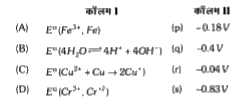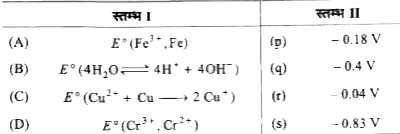मानक अपचायक विभव 25∘C पर निम्नलिखित है
E∘(Fe3+,Fe2+)=+0.77V
E∘(Fe2+.Fe)=−0.44V
E∘(Cu2+.Cu)=+0.34V,
E∘(Cu+.Cu)=+0.5V,
E∘(O2(g)+4H++4e−→2H2O)+1.2SV,
E∘(O2(g)+2H2O+4e−→4OH)=+0.40V
E∘(Cr3+.Cr)=−0.74V,
E∘(Cr2+.Cr)=−0.91V
कॉलम I में दिये गये रेडॉक्स युग्मों को कॉलम II में दिये गये अपचायक विभव से सुमेलित कीजिए।

The correct Answer is:A, B, C, D
A. 
⇒1×0.77+2×(−.44)=3×x
⇒x=−0.113V≅−0.04V
B. 4H2O⇔4H++4OH−
2H2O→O2+4H++4e− −1.23V
O2+2H2O+4e−→4OH− +0.4V
¯¯¯¯¯¯¯¯¯¯¯¯¯¯¯¯¯¯¯¯¯¯¯¯¯¯¯¯¯¯¯¯¯¯¯¯¯¯¯¯¯¯¯¯¯¯¯¯¯¯¯¯¯¯¯¯¯¯¯¯¯¯¯¯4H2OO⇔4H++4OH− −0.83V
C. 
×x1+0.52×1=0.34×2
x=0.16V
⇒Cu2=+e−→Cu+ 0.16V
+Cu→Cu++e −0.52V
¯¯¯¯¯¯¯¯¯¯¯¯¯¯¯¯¯¯¯¯¯¯¯¯¯¯¯¯¯¯¯¯¯¯¯¯¯¯¯¯¯¯¯¯¯¯¯¯¯¯¯¯¯¯¯¯¯Cu2++Cu→2Cu+ −0.36V
दिये गये विकल्प में −0.18V लिखा हुआ है।
D. 
x×1+2×(−0.91)=3×(−0.74)
x−1.82=−2.22
⇒x=−0.4V
Topper's Solved these Questions
- BOOK - ERRORLESS HINDICHAPTER - विद्युत रसायनEXERCISE - ASSERTION AND REASON20videos
विद्युत रसायन
- BOOK - ERRORLESS HINDICHAPTER - विद्युत रसायनEXERCISE - JEE ADVANCED(Integer type questions)6videos
विद्युत रसायन
- BOOK - ERRORLESS HINDICHAPTER - रेडॉक्स अभिक्रियाएँ EXERCISE - Assertion & Reason9videos
रेडॉक्स अभिक्रियाएँ
- BOOK - ERRORLESS HINDICHAPTER - विलयनEXERCISE - ASSERTION & REASON18videos
विलयन
Similar Questions
प्रक्कथनः मरकरी कैथोड पर हाइड्रोजन आयन की अपेक्षा सोडियम आयन विसर्जित होते हैं।
कारणः कैथोड की प्रकृति आयनों के विसर्जन की कोटि को प्रभावित कर सकती है।08:59View Solutionअभिक्रिया 43Al+O2→23Al2O3 के लिए ΔG,O2 का −772kJmol−1 है
Al2O3 के विद्युत अपघटन के लिए आवश्यक न्यूनतम EMF की (वोल्ट में) गणना करो07:07View Solutionप्रक्कथन : SO2 एवं Cl2 दोनों ही विरंजक हैं।
कारण : दोनों अपचायक हैं।08:59View Solutionप्रक्कथन : यदि विलायक में मिलाया गया द्रव विलेय विलायक की अपेक्षा अधिक वाष्पशील हो, तो विलयन का वाष्पदाब बढ़ सकता है, अर्थात् ps>p∘.
कारण : अधिक वाष्पशील द्रव विलेय की उपस्थिति में केवल विलेय वाष्प निर्मित करेगा एवं विलायक नहीं करेगा ।08:10View SolutionThe standard reduction potential data at 25∘C is given below
E∘(Fe3+,Fe2+)=+0.77V,
E∘(Fe2+,Fe)=−0.44V,
E∘(Cu2+,Cu)=+0.34V,
E∘(Cu+,Cu)=+0.52V,
E∘(O2(g)+4H++4e−→2H2O]=+1.23V
E∘[(O2(g)+2H2O+4e−→4OH−)]=+0.40V,
E∘(Cr3+,Cr)=−0.74V,
E∘(Cr2+,Cr)=−0.91V,
Match E∘ of the redox pair in List-I with the values given in List-II and select the correct answer using the code given below teh lists:
List−IList−II(P)E∘(Fe3+,Fe)(1)−0.18V(Q)E∘(4H2O⇔4H++4OH+)(2)−0.4V(R)E∘(Cu2++Cu→2Cu+)(3)−0.04V(S)E∘(Cr3+,Cr2+)(4)−0.83V
Codes:01:52View SolutionWhat is the potential for the cell Cr|Cr^(3+)(0.1M)||Fe^(2+)(0.01M)|Fe E^(@)Cr^(3+)// Cr=-0.74V , E^(@)Fe^(2+)//Fe=-0.44V
07:16View SolutionThe standard reduction potential data at 25∘C is given below
E∘(Fe3+,Fe2+)=+0.77V,
E∘(Fe2+,Fe)=−0.44V,
E∘(Cu2+,Cu)=+0.34V,
E∘(Cu+,Cu)=+0.52V,
E∘(O2(g)+4H++4e−→2H2O]=+1.23V
E∘[(O2(g)+2H2O+4e−→4OH−)]=+0.40V,
E∘(Cr3+,Cr)=−0.74V,
E∘(Cr2+,Cr)=−0.91V,
Match E∘ of the redox pair in List-I with the values given in List-II and select the correct answer using the code given below teh lists:
List−IList−II(P)E∘(Fe3+,Fe)(1)−0.18V(Q)E∘(4H2O⇔4H++4OH+)(2)−0.4V(R)E∘(Cu2++Cu→2Cu+)(3)−0.04V(S)E∘(Cr3+,Cr2+)(4)−0.83V
Codes:02:23View Solutionमानक अपचायक विभव 25∘C पर निम्नलिखित हैं
E∘(Fe3+.Fe2+)=+0.77VE∘(Fe2+/Fe)=−0.44VE∘(Cu2+/Cu)=+0.34VE∘(Cu+/Cu)=+0.52V
(E∘(O2(g)+4H++4e−→2H2O)=+1.23V,),(E∘(O2(g)+2H2O+4e−→4OH)=+0.40V),(E∘(Cr3+/Cr)=−0.74V, E∘(Cr2+/Cr)=−0.71V)
स्तम्भ I में दिए गए रेडॉक्स युग्मों को स्तम्भ II में दिए गए अपचायक विभव से सुमेलित कीजिए तथा स्तम्भ के नीचे दिए गए कोड का प्रयोग करके सही उत्तर चुनिए |
 02:23View Solution
02:23View SolutionE∘ of Fe∣Fe2+ is +0.44V , E∘ of Cu∣Cu2+ is -0.32V. Then in the cell
06:39View SolutionWhat is the potential for the cell Cr|Cr^(3+)(0.1M)||Fe^(2+)(0.01M)|Fe E^(@)Cr^(3+)// Cr=-0.74V , E^(@)Fe^(2+)//Fe=-0.44V
01:41View SolutionStandard E∘ of the half cell Fe/Fe2+ is +0.44V and standard E∘ of half cell Cu /Cu2+ is -0.32V then:
03:31View SolutionStandard E^@ of the half cell Fe [Fe^(2+) is +0.44V and standard E^@ of half cell Cu ]Cu^(2+) is -0.32V then:
04:00View Solution(i)E∘(Cu2+,Cu)=0.34V
(ii) E∘(Cu+,Cu)=+0.52V
(iii)E∘[O2(g)+H++4e→4OH−]=+1.23V
(iv)E∘[O2(g)+2H2O+4e→4OH−]=+0.40V
(v) E∘(Cr3+,Cr)=−0.74V
(vi)E∘(Cr2+,Cr)=+0.91V
Match E∘ of the redox pair is List I with the values given in List II and select the correct answer using the code given below the lists.
 06:26View Solution
06:26View SolutionGiven that the standard elctrode potentials (EΘ) of metals are:
K+/K=−2.93V,Ag+/g=0.80V,
Cu2+/Cu=0.34V,Mg2+/Mg=−2.37V,
Cr3+/Cr=−0.74V,Fe2+/Fe=−0.44V.
Arrange these metals in an increasing order of their reducing power.05:36View SolutionCalculate the emf of the cell Cr∣ Cr^(3+)(0.1 M)∣∣Fe^(2+) (0.01M)∣Fe (Given: E^(@)Cr^(3+) /Cr =−0.75 volt; E^(@)Fe^(2+) /Fe =−0.45 volt).
09:37View Solution

